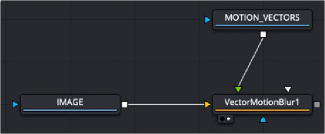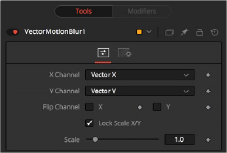
< Previous | Contents | Next >
The Settings tab in the Inspector is also duplicated in other Blur nodes. These common controls are described in detail at the end of this chapter in “The Common Controls” section.
Vector Motion Blur [VMB]

The Vector Motion Blur node
Vector Motion Blur Introduction
This node is used to create directional blurs based on a Motion Vector map or AOV (Arbitrary Output Variable) channels exported from 3D-rendering software like Arnold, Renderman, or VRay. You can also generate motion vectors using the Optical Flow node in Fusion.
The vector map is typically two floating-point images: one channel specifies how far the pixel is moving in X, and the other specifies how far the pixel is moving in Y. These channels may be
embedded in OpenEXR or RLA/RPF images, or may be provided as separate images using the node’s Vectors input.
The vector channels should use a float16 or float32 color depth, to provide + and – values.
![]()
A value of 1 in the X channel would indicate that pixel has moved one pixel to the right, while a value of –10 indicates ten pixels of movement to the left.
Inputs
The Vector Motion Blur node has three inputs for a 2D image, a motion vector pass, and an effect mask.
— Input: The required orange input is for a 2D image that receives the motion blur.
— Vectors: The green input is also required. This is where you connect a motion vector AOV rendered from a 3D application or an EXR file generated from the Optical Flow node in Fusion.
— Vector Mask: The white Vector Mask input is an optional input that masks the image before processing.
— Effect Mask: The common blue input is used for a mask shape created by polylines, basic primitive shapes, paint strokes, or bitmaps from other tools. Connecting a mask to this input restricts the source of the motion blur to only those pixels within the mask. An effect mask is applied to the tool after it is processed.
Basic Node Setup
The Vector Motion Blur node receives a 2D image like the IMAGE shown below. A MediaIn or Loader node containing motion vectors is connected to the Vector’s input. The output continues the node tree by connecting to another 2D image-processing node or a Merge node.

A Vector Motion Blur node applied to a MediaIn or Loader node with motion vectors connected to the Vectors input
Inspector

![]()
Vector Motion Blur node
Controls Tab
The Controls tab contains all the primary controls necessary for customizing the Vector Motion Blur operation.
Use this menu to select which channel of the image provides the vectors for the movement of the pixels along the X-axis.
Use this menu to select which channel of the image provides the vectors for the movement of the pixels along the Y-axis.
These checkboxes can be used to flip, or invert, the X and Y vectors. For instance, a value of 5 for a pixel in the X-vector channel would become –5 when the X checkbox is enabled.
Selecting this checkbox provides access to separate sliders for X and Y Scale. By default, only a single Scale slider is provided.